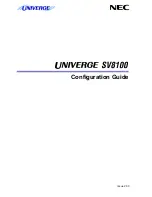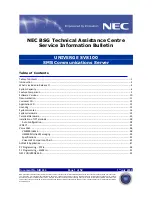
5-2 Problem Solving
Problem Solving
This chapter helps you identify and solve problems that may occur during system
installation or while using your system. The first section of this chapter tells you how to
reset your system in the event of problems. The next few sections provide
troubleshooting checklists and procedural steps that help you isolate specific system
problems. The last section includes BIOS, system, and disk status user information.
!
WARNING
The DC push-button on/off switch on the front panel does not turn off
the system AC power. Also, +5vdc is present on the system board
whenever the AC power cord is connected between the system and
an AC outlet. Before doing the procedures in this manual, make sure
that your system is powered off and unplug the AC power cords from
the back of the chassis. Failure to disconnect power before opening
your system can result in personal injury and equipment damage
!
CAUTION
Operating your system with the side panels removed can damage
your system components. For proper cooling and airflow, always
replace the side panels before powering on your system.
Static Precautions
An electrostatic discharge (ESD) can damage disk drives, option boards, and other
components. You can provide some ESD protection by wearing an antistatic wrist strap
attached to chassis ground when handling system components.
Electronic devices can be easily damaged by static electricity. To prevent damage, keep
them in their protective packaging when they are not installed in your system.
Resetting the System
To do this:
Press:
Soft boot reset, which clears system memory and reloads the operating
system.
Ctrl+Alt+Del
Clear system memory, restart POST, and reload the operating system.
Reset button
Cold boot reset. Turn the system power off and then on. This clears
system memory, restarts POST, reloads the operating system, and halts
power to all peripherals.
Power off/on
Fault Resilient Booting
Fault resilient booting insures the system will not stop from a boot problem. Two sets of
timers are implemented in the BMC that will automatically reset the system if the
system should halt for some reason. Refer to "Fault Resilient Booting (FRB) Timer
Enable Jumper" in Chapter 3.
Summary of Contents for NEAX Express
Page 1: ...U s e r s G u i d e NEAX Express...
Page 2: ......
Page 3: ...U s e r s G u i d e NEAX Express...
Page 10: ...viii Contents...
Page 36: ...1 20 System Overview...
Page 80: ...3 30 Configuring Your System...
Page 136: ...5 22 Problem Solving...
Page 137: ...A System Cabling System Cabling Before You Begin Static Precautions Standard Configuration...
Page 142: ...A 6 System Cabling...
Page 180: ...C 20 Emergency Management Port...
Page 181: ...D Platform Event Paging...
Page 192: ...10 Glossary...
Page 198: ...Index 4...
Page 199: ...xx...
Page 200: ...456 01509 000...
















































